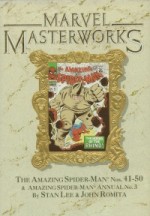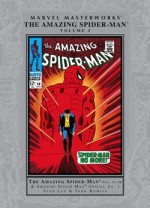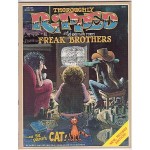
By Dan Slott, Fred Van Lente, Rick Remender, Humberto Ramos, Stefano Caselli  & various (Marvel/Panini UK)
ISBN: 978-1-84653-501-7
When the Spider-Man continuity was drastically and controversially altered for the ‘Brand New Day’ publishing event a refreshed, now single-and-never-been-married Peter Parker was parachuted into a new life, so if this is your first Web-spinning yarn in a while – or if you’re drawing your cues from the movies – prepare yourself for a little confusion. That being said, this classy collection of Web-spun wonderment is more accessible than most: a spectacular summer blockbuster yarn with New York overwhelmed by monsters, a hideous all-consuming threat and packed to the spiracles (look it up: I’m being clever again) with returning villains from Spidey’s less complicated glory-days…
Gathering Spider-Island: Deadly Foes, Amazing Spider-Man #666-672, Venom #6-8, and background material, original art, text-features and interviews from Marvel Spotlight Spider-Island, the manic Marvel mayhem commences when clone-builder Miles Warren AKA The Jackal resurrects the warped Peter Parker doppelganger Kaine and upgrades him for malicious purposes and a hidden new boss; turning the recent cadaver into a monstrous multi-limbed humanoid Tarantula…
Meanwhile in ‘Prologue: the One and Only’ the webslinger is riding a wave of popularity in New York City despite every effort of new Mayor J. Jonah Jameson and even in his civilian identity is having a pretty good life. The original hard-luck kid has a great, well-paid job designing high-tech gadgets, is fast friends with the city’s greatest scientists Tony Stark and Reed Richards and even has a devoted, hot, new girlfriend; forensic cop Carlie Cooper.
But now, something very strange is happening: all over Manhattan people are starting to manifest spider-powers and government asset Flash Thompson is put on alert in his role as new black-ops agent Venom, keeping the supposedly retired and disabled war-hero from the bedside of his estranged and terminal father…
When Peter recently lost his Spider-sense, clairvoyant arachnid hero Madame Web convinced him to study martial arts with Shang-Chi, fabled Master of Kung Fu, to prepare for a dire future crisis, but his hectic schedule – constantly moving from Horizon Labs to Fantastic Four HQ and Avengers Mansion – means he is one of the last to know that a manufactured plague is turning New York into a city of Spider People, just as Jackal, Tarantula and their sultry secret leader are unleashing yet another arachnoid atrocity…
‘The Amazing Spider-Manhattan’ sees the infestation grow as Carlie reveals she has Spider-powers and the Jackal assembles an army of arachnid-enhanced thugs to plunder and run riot, further spreading the contagion. A city-wide epidemic forces Jameson to close all exits from the New York and quarantine the populace as the superheroes begin a desperate holding action against a wave of wall-crawling criminals.
When the original-and-genuine tries to join them in ‘Peter Parker, the Unspectacular Spider-Man’ he is sent away since he’s indistinguishable from many of the thugs, but the indomitable lad soon finds a way to strike back and even recruit reinforcements for the hard-pressed defenders.
Across town Venom is stalking the cause of the plague and Eddie Brock, originally possessed by the selfsame alien Symbiote, discovers that he has become a natural cure for the Spider-infection: a living ‘Anti-Venom’…
The covert paramilitary predator had overcome and captured the Jackal’s new Spider-King, but the whole operation was a trick; allowing the beast to sneak thousands of spider-babies out of the quarantined city, ready to infect the entire country. Moreover when Flash discovers that the original identity of the horrific Spider-King was in fact America’s greatest hero he is caught between honour and duty…
In ‘Arachnotopia’ Peter Parker is leading the fightback but helpless to combat the next stage of the disease as victims begin to mutate from spider-powered humans into carnivorous, monstrous eight-legged freaks. His life is made even more difficult when he sees Carlie so clearly using his powers better than he ever did…
Meanwhile Reed Richards, frantically seeking a cure, sees that complete infestation of Manhattan is only a matter of hours away…
With the mystery mastermind revealed there are ‘Spiders, Spiders Everywhere’ but a glimmer of hope remains as Flash/Venom infiltrates the Queen’s arachnoid inner circle, just as Peter’s old flame Mary Jane Watson discovers her own inner arthropod and joins the struggle armed with an advantage no other infectee can – or would want to – boast…
The next Venom instalment sees Flash clash with Anti-Venom before dragging the all-too-willing Brock back to Reed Richards…
Meanwhile the Queen has established mental contact with every victim and uses them as a battery: a web of life feeding her transformative energy and, when the cure is synthesised, she compels all her thralls to resist it and the people administering it…
In the final Venom episode Flash valiantly tackles the Queen head-on but is easily defeated. Luckily one of the first infectees to be cured was that legendary hero trapped inside the Spider-King…
Unfortunately the disease has already reached peak infection and the triumphant Queen transforms into a skyscraper-sized arachnoid colossus ready and able to turn the world into a planet of spiders. With everything to fight for and no hope, Mary Jane and a most unexpected ally lead one final assault by the remaining assembled heroes on the monumental monstrosity, giving the one true Amazing Spider-Man a valiant last chance to spectacularly save everyone…
In ‘Epilogue: the Naked City’ a city wide “Morning After†focuses on the staggering aftermath of the climactic clash and cannily resets the scene for a fresh start in the Spidey universe with departures, arrivals and a whole new outlook for Marvel’s most iconic hero…
Although not necessary, readers might also benefit from a quick re-reading of Spectacular Spider-Man: Disassembled, but this gloriously bombastic rollercoaster action-romp from writers Dan Slott, Fred Van Lente and Rick Remender, illustrated by Humberto Ramos, Stefano Caselli, Tom Fowler, Minck Oosterveer, Carlos Cuevas, Victor Olazaba & Karl Kesel forms not only a terrific Fights ‘n’ Tights tale but also serves as a stand-alone saga and perfect jumping-on point for readers new or returning. With the aforementioned added features pages and a stunning gallery of variant covers by
Ramos, Greg Land, Gabriele Dell’Otto, Stephanie Hans & Stuart Immonen Spider-Island is possibly one of the best Spider-Man books in years.
This British edition of Amazing Spider-Man: Spider Island is set for release on January 19th 2012.
™ & © 2012 Marvel & Subs. Licensed by Marvel Characters B.V. through Panini S.p.A. Italy. A British Edition by Panini UK Ltd.










